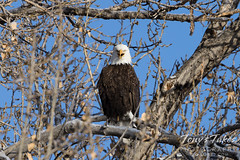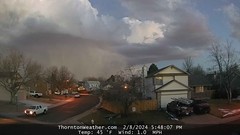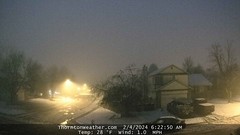
Damaging winds are not uncommon along the Colorado Front Range, particularly this time of year when strong Bora and Chinook winds can rage. We see a number of such events in our look back at this week in Denver weather history. Also making an appearance are a number of notable snow and cold events.
From the National Weather Service:
16-18
In 1970…a wind gust to 90 mph was recorded in Boulder at the National Center for Atmospheric Research. In downtown Boulder…sustained winds of 30 to 40 mph with gusts to 53 mph were measured. Damage was minor. West winds gusted to 45 mph at Stapleton International Airport on the 17th. The strong Chinook winds warmed the temperature to 70 degrees on the 16th and to 72 degrees on the 17th…both records for the date. The low temperature dipped to only 32 degrees on the 16th equaling the record high minimum for the date.
17-18
In 1976…a strong cold front produced wind gusts 30 to 60 mph with much blowing snow and severe dust storms. In the Boulder area…high winds collapsed a garage and broke some windows. Northwest winds gusted to 43 mph on the 17th and to 44 mph on the 18th at Stapleton International Airport.
In 1984…the third blizzard in a week struck eastern Colorado. Heavy snow hit some parts of metro Denver with 8 to 10 inches measured in Aurora…but only 2.9 inches of snow fell at Stapleton International Airport where northwest winds gusted to 31 mph.
In 1999…damaging downslope Bora winds developed in the foothills behind a strong cold front. Peak wind reports included: 90 mph at the Gamow Tower on the University of Colorado campus in Boulder; 79 mph at the National Center for Atmospheric Research mesa lab near Boulder and at the national wind technology center south of Boulder; and 72 mph atop Blue Mountain and at Jefferson County Airport. Downed power lines caused major outages for at least 10 thousand residents in Evergreen…Idaho Springs…Golden… And Lakewood. In Golden…the wind toppled a lightning static protection line atop a 70-foot…230 thousand-volt distribution tower. The downed line…sparked a small grass fire just east of the Lookout Mountain youth services center. The fire burned a path approximately 100 yards wide and 1/3 mile long before it was contained.
In 2000…snow…heavy in the mountains and foothills…spread over metro Denver. Snowfall totaled 24 inches at the Eldora Ski Resort with 8 inches measured near Blackhawk. Snowfall was only 1.8 inches at the site of the former Stapleton International Airport…which was the only measurable snow of the month.
In 2018…high winds developed over portions of the Front Range mountains and foothills. Peak wind gusts included: 98 mph… 2 miles south-southeast of Gold Hill…86 mph atop Berthoud Pass…with 75 mph…3 miles east of Gold Hill.
In 2021…a storm system produced moderate to heav snow which impacted locations in and near the Front Range Foothills and Palmer Divide. Storm totals included: 12.5 inches at Conifer…11 inches near Evergreen…Larkspur and Morrison… 10.5 inches near Genesee and Pinecliffe…10 inches near Jamestown…9 inches near Crisman and Marshall…8.5 inches near Eldorado Springs…8 inches in Boulder and Monument; 6 inches near Ken Caryl…Lafayette and Niwot; 5.5 inches at the National Weather Service Office in Boulder…with 5 inches in Arvada and Hygiene. At Denver International Airport…0.8 inch of snowfall was observed.
17-19
In 2006…a cold spell resulted in 4 temperature records. Low temperatures of 10 degrees below zero on the 17th… 13 degrees below zero on the 18th…and 4 degrees below zero on the 19th were record minimums for those dates. The high temperature of only 7 degrees on the 18th was a record low maximum for the date. Light snow fell on the 17th…but totaled less than half an inch at Denver International Airport.
18
In 1918…post-frontal northwest winds were sustained to 40 mph with a measured extreme velocity to 44 mph.
In 1937…a moderate duststorm occurred during the late afternoon and early evening. Northeast winds sustained to 32 mph with gusts to 41 mph reduced the visibility to 1/2 mile which persisted for about 40 minutes in the city.
In 1998…rare thunder from instability rain and snow showers was heard in Littleton during the late afternoon. Thunder in February only occurs about once every 10 years over metro Denver.
18-19
In 1954…a vigorous cold front produced north winds gusting to 56 mph and a trace of snowfall at Stapleton Airport on the 18th. Strong and gusty winds to 55 mph persisted through the next day and caused some blowing dust.
In 1955…a storm dumped heavy snow across metro Denver. At Stapleton Airport where north winds sustained to 28 mph produced some blowing snow…snowfall totaled 8.8 inches.
18-20
In 1913…post-frontal snowfall totaled 6.9 inches in downtown Denver over the 3 days. Most of the snow fell on the 19th. Northeast winds were sustained to 21 mph with a measured extreme velocity to 24 mph on the 18th.
In 1924…light snowfall totaled 4.6 inches over the 3 days. This was the only measurable snowfall of the month. High temperatures plunged from 45 degrees on the 18th to 17 degrees on the 20th. Low temperatures dipped from 31 degrees on the 18th to only 8 degrees on the 20th. Northeast winds were sustained to 24 mph on the 19th.
In 1953…a major blizzard dumped 10.6 inches of snowfall at Stapleton Airport. Strong north winds at sustained speeds of 25 to 35 mph with gusts as high as 44 mph frequently reduced visibilities to 1/4 mile in blowing snow during the day of the 19th. The strong winds caused much drifting snow…making accurate snowfall measurements almost impossible. Precipitation from the storm totaled 1.13 inches. The 1.01 inches of precipitation on the 19th was the greatest calendar day and 24 hour precipitation ever recorded in the city during the month of February.
In 1987…large amounts of new snow fell in the Front Range foothills. The foothills received 10 to 20 inches of new snow with 4 to 8 inches on the adjacent plains. On the 19th…flight delays occurred at Stapleton International Airport where snowfall totaled 4.2 inches and east winds gusted to only 18 mph on the 19th. Schools were closed in the foothills above Boulder.
19
In 1899…northwest winds sustained to 42 mph with gusts to 45 mph warmed the temperature to a high of 56 degrees… The highest reading of the month that year.
In 1980…high winds were reported in Boulder. Sustained speeds of 50 to 60 mph with gusts to 85 mph were measured. West winds gusted to 31 mph at Stapleton International Airport.
In 1986…Chinook winds continued to buffet the eastern foothills. Winds gusting from 60 to 75 mph were common in the foothills. West winds gusted to 41 mph at Stapleton International Airport.
In 1996…high winds gusting from 70 to 75 mph were reported atop Table Mesa near Boulder. West winds gusted to 44 mph at Denver International Airport.
In 2007…this was the last day of 61 consecutive days with snow cover of 1 inch or more in Denver. This second longest period of snow cover on record began with the blizzard on December 20-21…2006…when 20.7 inches of snow fell at the site of the former Stapleton International Airport where official snow measurements were taken. Additional snowfall during December…January…and February prolonged the event. Snow depth on the ground was measured to the nearest inch once daily at 6:00 am MST.
In 2018…a storm system brought a period of upslope snowfall to locations in and near the Front Range Foothills. Storm totals included: 9 inches in Louisville…8.5 inches at Lafayette and 2 miles south of Rocky Flats National Wildlife Refuge…8 inches…2 miles south of Boulder and 3 miles north-northeast of Eldorado Springs; 7.5 inches in Erie…7 inches…3 miles west-northwest of Arvada and at the National Weather Service in Boulder; 6 inches at Copeland Lake… Evergreen…3 miles northwest of Idledale and Intercanyon. At Denver International Airport…a trace of snowfall was observed.
19-20
In 1937…post-frontal heavy snowfall totaled 8.4 inches over downtown Denver. Most of the snow…6.6 inches…fell on the 20th when north winds were sustained to 16 mph with gusts to 18 mph. The temperature dipped to a low of 9 degrees on the 20th.
In 1939…post-frontal snowfall totaled 5.4 inches in the city. The snow covered streets and highways with a coating of ice as the temperature fell from 36 degrees at 2:00 pm on the 19th to a low of 4 degrees at 3:00 am on the 20th. Many motorists were marooned for several hours. Northeast winds were sustained to 24 mph on the 19th.
19-21
In 1971…heavy snowfall totaled 9.0 inches at Stapleton International Airport where north winds gusted to only 16 mph. Most of the snow occurred on the 19th and 20th. The 24 hour snowfall of 8.2 inches was the greatest in February since 1953.
Continue reading February 18 to February 24: This week in Denver weather history →



































































